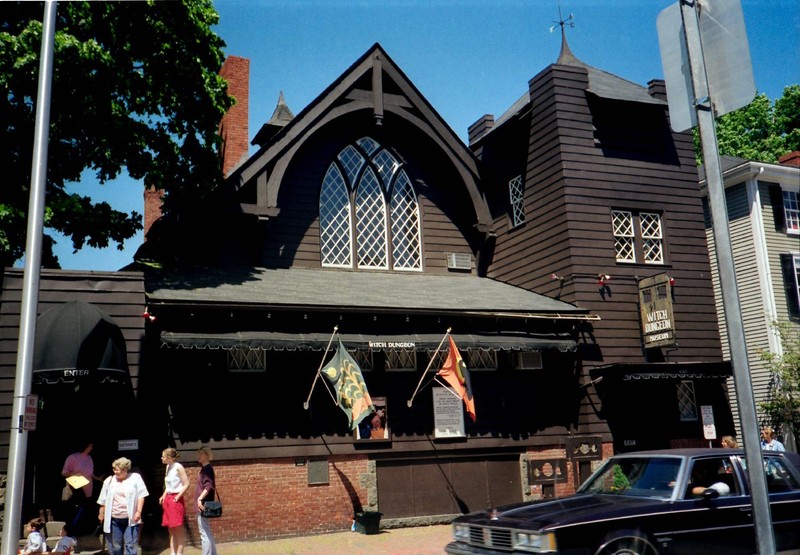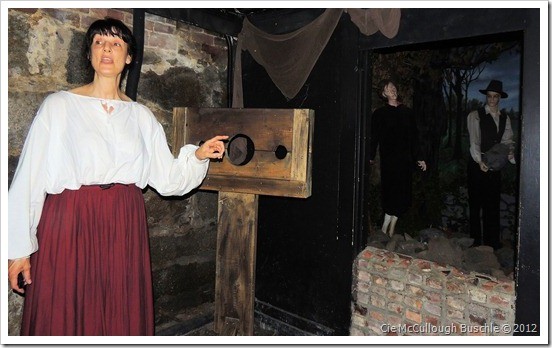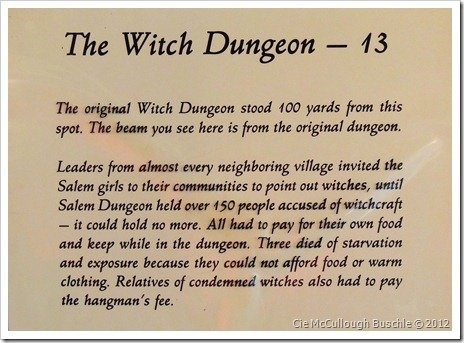Witch Dungeon Museum
Introduction
Text-to-speech Audio
Images
Witch Dungeon Museum

Reenactment of the Salem Witch Trials

One of the placards displayed in the museum's courtroom.

Backstory and Context
Text-to-speech Audio
The Witch Dungeon Museum in Salem, Massachusetts takes its visitors back to a time in the colonial era, where accusations and injustice were rampant in the small village. After a quick story about what was going on at the time, the guests are taken into a small courtroom to witness a reenactment of the trial of Elizabeth Proctor, one of the women accused of witchcraft. The jury box is filled with a dozen wax figures. Only the prosecutor and the accused are live actors. According to several reviews, the actors are very entertaining and animated. The prosecutor fights off an invisible presence, while screaming “She has the devil's mark! She's biting me!!!” After the reenactment is over, the tour is led through a series of dark dungeon rooms.
The dungeon rooms are reproduced from artifacts found during archaeological digs at the site of the original dungeon. There were hundreds of men, women and children held in these “coffin cells” during the paranoia merely on the suspicion of witchcraft. Some of the rooms depict scenes from the witch trials, including a representation of Giles Corey, the only person convicted of witchcraft who was executed by being pressed to death with stones.
Along the walls of the courtroom are several white placards like the one shown above. They provide additional details about the trials and the dungeon that held the accused. Three of them died while being held in the dungeons below the courtroom, because they could not afford to pay for their own food or clothing.
A Brief Overview of the Witch Trials
The Salem Witch trials took place from 1692 to 1693. Nearly 200 people were accused of witchcraft during this time period. Twenty of the accused were convicted and executed – 19 by hanging and another was pressed to death by stones. The paranoia started when the new minister’s two young daughters and another girl began to experience violent fits of screaming and contortion. They blamed several local women for their bizarre behavior. There is speculation that it was easy to accuse someone of witchcraft, so others began to accuse neighbors and rivals as revenge. The witchcraft craze soon ended and the colony began to apologize to the families of those accused and executed. Salem is still synonymous with witches, paranoia, and mass injustice. There are several museums and historic sites commemorating the town’s curious past.
Sources
Home, Hours. Witch Dungeon Museum. Accessed October 09, 2017. http://www.witchdungeon.com/witchdungeon.html.
The Witch Dungeon Museum. Roadside America. Accessed October 09, 2017. https://www.roadsideamerica.com/story/2110.
Blumberg, Jess. A Brief History of the Salem Witch Trials: One town’s strange journey from paranoia to pardon. Smithsonian. October 23, 2007. Accessed October 09, 2017. https://www.smithsonianmag.com/history/a-brief-history-of-the-salem-witch-trials-175162489/.
